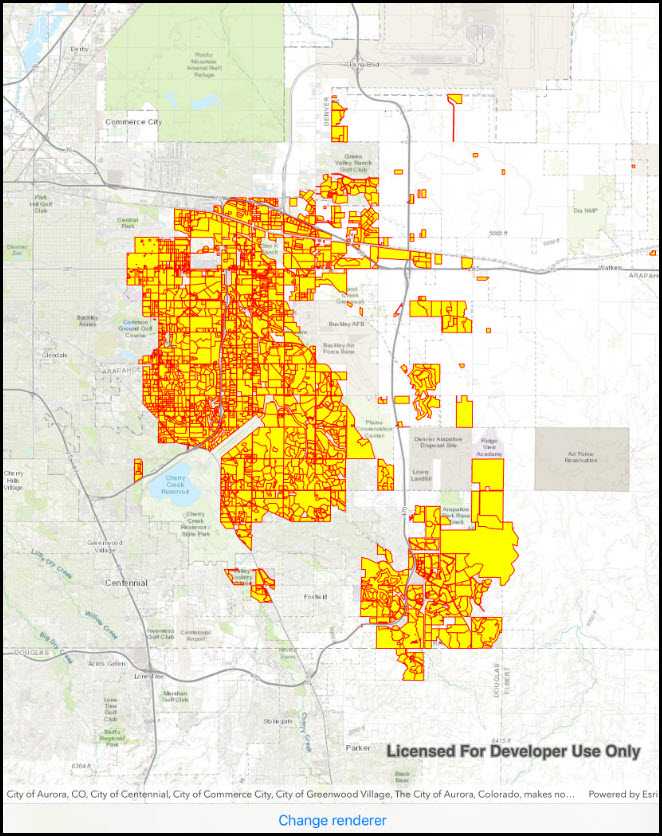Display a shapefile with custom symbology.

Use case
Feature layers created from shapefiles do not possess any rendering information, and will be assigned with a default symbology. You can apply custom styling to ensure that the content is visible and usable in the context of a specific map. For example, you could use this to visually differentiate between features originating from two different shapefiles, by applying a blue color to one, and a red color to the other.
How to use the sample
Tap the button to apply a new symbology renderer to the feature layer created from the shapefile.
How it works
- Create a
ShapefileFeatureTable, providing the path to a shapefile. - Create a
FeatureLayerand associate it with theShapeFileFeatureTable. - Create a
SimpleRendererto override the default symbology. The simple renderer takes a symbol and applies that to all features in a layer. - Apply the renderer to the
FeatureLayerby setting the renderer.
Relevant API
- FeatureLayer
- ShapefileFeatureTable
- SimpleFillSymbol
- SimpleLineSymbol
- SimpleRenderer
Offline data
This sample downloads the following items from ArcGIS Online automatically:
- Aurora_CO_shp.zip - Shapefiles that cover Aurora Colorado: Public art (points), Bike trails (lines), and Subdivisions (polygons).
About the data
This sample displays a shapefile containing subdivisions in Aurora, CO.
Additional information
While shapefiles contain no rendering information, other data sources such as Service Feature Tables or Geodatabase Feature Tables can contain such information. As a result, the rendering properties of the other data sources can be pre-defined by the author.
Tags
package, shape file, shapefile, symbology, visualization
Sample Code
// Copyright 2017 Esri.
//
// Licensed under the Apache License, Version 2.0 (the "License"); you may not use this file except in compliance with the License.
// You may obtain a copy of the License at: http://www.apache.org/licenses/LICENSE-2.0
//
// Unless required by applicable law or agreed to in writing, software distributed under the License is distributed on an
// "AS IS" BASIS, WITHOUT WARRANTIES OR CONDITIONS OF ANY KIND, either express or implied. See the License for the specific
// language governing permissions and limitations under the License.
using System;
using ArcGISRuntime.Samples.Managers;
using Esri.ArcGISRuntime.Data;
using Esri.ArcGISRuntime.Geometry;
using Esri.ArcGISRuntime.Mapping;
using Esri.ArcGISRuntime.Symbology;
using Esri.ArcGISRuntime.UI.Controls;
using Foundation;
using UIKit;
namespace ArcGISRuntime.Samples.SymbolizeShapefile
{
[Register("SymbolizeShapefile")]
[ArcGISRuntime.Samples.Shared.Attributes.OfflineData("d98b3e5293834c5f852f13c569930caa")]
[ArcGISRuntime.Samples.Shared.Attributes.Sample(
name: "Symbolize shapefile",
category: "Data",
description: "Display a shapefile with custom symbology.",
instructions: "Tap the button to apply a new symbology renderer to the feature layer created from the shapefile. ",
tags: new[] { "package", "shape file", "shapefile", "symbology", "visualization" })]
public class SymbolizeShapefile : UIViewController
{
// Hold references to UI controls.
private MapView _myMapView;
private UIBarButtonItem _changeRendererButton;
// Hold reference to the feature layer so that its renderer can be changed when button is pushed.
private FeatureLayer _shapefileFeatureLayer;
// Hold reference to default renderer to enable switching back.
private Renderer _defaultRenderer;
// Hold reference to alternate renderer to enable switching.
private SimpleRenderer _alternateRenderer;
public SymbolizeShapefile()
{
Title = "Symbolize a shapefile";
}
private async void Initialize()
{
// Create the point for the map's initial viewpoint.
MapPoint point = new MapPoint(-11662054, 4818336, SpatialReference.Create(3857));
// Create and show a map with topographic basemap.
Map myMap = new Map(BasemapStyle.ArcGISTopographic)
{
InitialViewpoint = new Viewpoint(point, 200000)
};
// Get the path to the shapefile.
string shapefilePath = DataManager.GetDataFolder("d98b3e5293834c5f852f13c569930caa", "Subdivisions.shp");
// Create a shapefile feature table from the shapefile path.
ShapefileFeatureTable featureTable = new ShapefileFeatureTable(shapefilePath);
// Create a layer from the feature table.
_shapefileFeatureLayer = new FeatureLayer(featureTable);
// Add the layer to the map.
myMap.OperationalLayers.Add(_shapefileFeatureLayer);
// Create the symbology for the alternate renderer.
SimpleLineSymbol lineSymbol = new SimpleLineSymbol(SimpleLineSymbolStyle.Solid, System.Drawing.Color.Red, 1.0);
SimpleFillSymbol fillSymbol = new SimpleFillSymbol(SimpleFillSymbolStyle.Solid, System.Drawing.Color.Yellow, lineSymbol);
// Create the alternate renderer.
_alternateRenderer = new SimpleRenderer(fillSymbol);
try
{
// Wait for the layer to load so that it will be assigned a default renderer.
await _shapefileFeatureLayer.LoadAsync();
// Hold a reference to the default renderer (to enable switching between the renderers).
_defaultRenderer = _shapefileFeatureLayer.Renderer;
// Add the map to the mapview.
_myMapView.Map = myMap;
// Enable changing symbology now that sample is loaded.
_changeRendererButton.Enabled = true;
}
catch (Exception e)
{
new UIAlertView("Error", e.ToString(), (IUIAlertViewDelegate) null, "OK", null).Show();
}
}
private void ChangeRenderer_Clicked(object sender, System.EventArgs e)
{
// Toggle the renderer.
if (_shapefileFeatureLayer.Renderer == _defaultRenderer)
{
_shapefileFeatureLayer.Renderer = _alternateRenderer;
}
else
{
_shapefileFeatureLayer.Renderer = _defaultRenderer;
}
}
public override void ViewDidLoad()
{
base.ViewDidLoad();
Initialize();
}
public override void LoadView()
{
// Create the views.
View = new UIView {BackgroundColor = ApplicationTheme.BackgroundColor};
_myMapView = new MapView();
_myMapView.TranslatesAutoresizingMaskIntoConstraints = false;
_changeRendererButton = new UIBarButtonItem();
_changeRendererButton.Title = "Change renderer";
_changeRendererButton.Enabled = false;
UIToolbar toolbar = new UIToolbar();
toolbar.TranslatesAutoresizingMaskIntoConstraints = false;
toolbar.Items = new[]
{
new UIBarButtonItem(UIBarButtonSystemItem.FlexibleSpace),
_changeRendererButton,
new UIBarButtonItem(UIBarButtonSystemItem.FlexibleSpace)
};
// Add the views.
View.AddSubviews(_myMapView, toolbar);
// Lay out the views.
NSLayoutConstraint.ActivateConstraints(new[]
{
_myMapView.TopAnchor.ConstraintEqualTo(View.SafeAreaLayoutGuide.TopAnchor),
_myMapView.LeadingAnchor.ConstraintEqualTo(View.LeadingAnchor),
_myMapView.TrailingAnchor.ConstraintEqualTo(View.TrailingAnchor),
_myMapView.BottomAnchor.ConstraintEqualTo(toolbar.TopAnchor),
toolbar.BottomAnchor.ConstraintEqualTo(View.SafeAreaLayoutGuide.BottomAnchor),
toolbar.LeadingAnchor.ConstraintEqualTo(View.LeadingAnchor),
toolbar.TrailingAnchor.ConstraintEqualTo(View.TrailingAnchor),
});
}
public override void ViewWillAppear(bool animated)
{
base.ViewWillAppear(animated);
// Subscribe to events.
_changeRendererButton.Clicked += ChangeRenderer_Clicked;
}
public override void ViewDidDisappear(bool animated)
{
base.ViewDidDisappear(animated);
// Unsubscribe from events, per best practice.
_changeRendererButton.Clicked -= ChangeRenderer_Clicked;
}
}
}